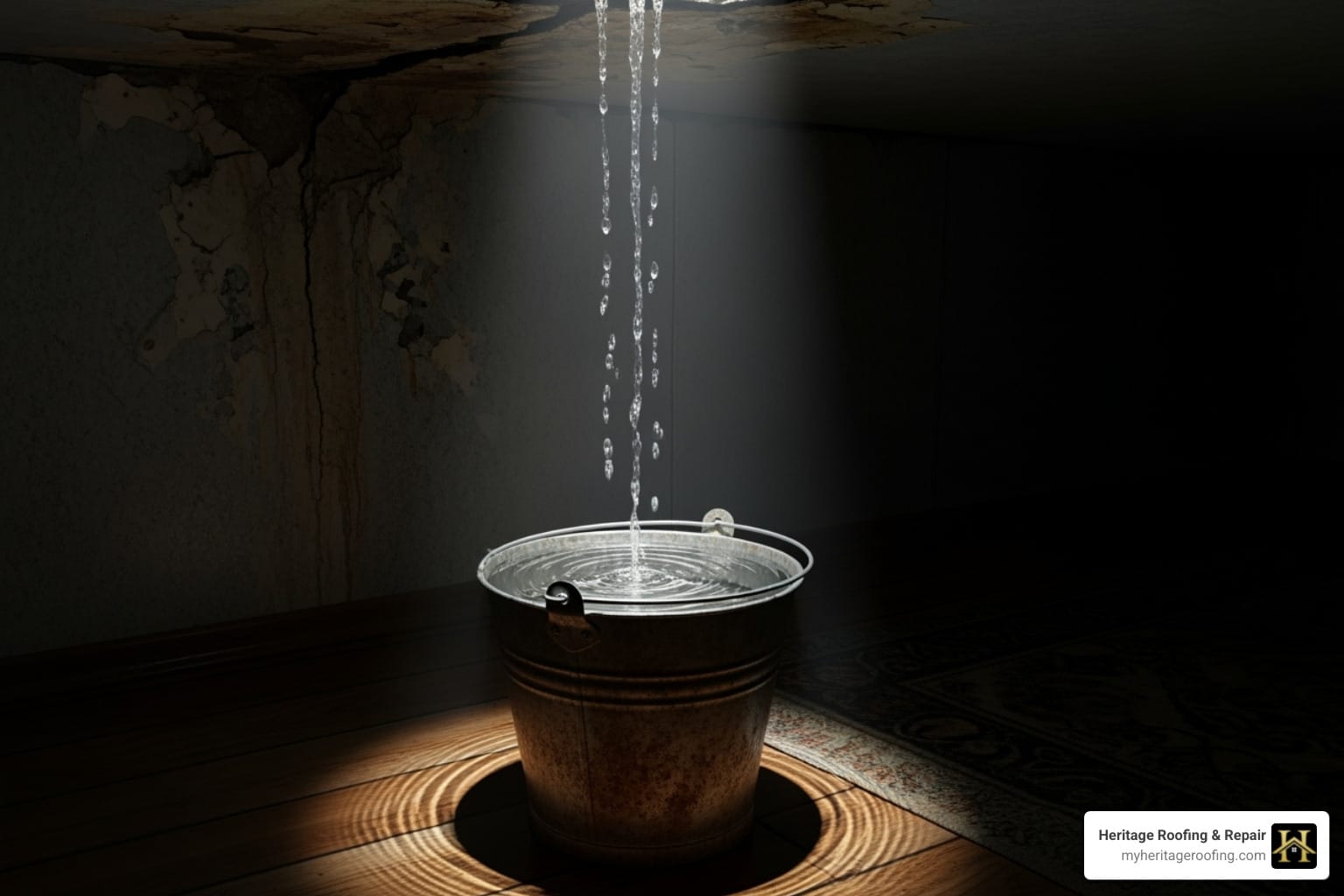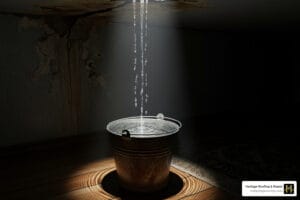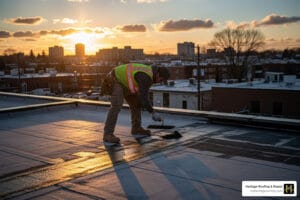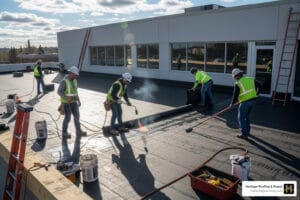Don’t Panic, Take Action
A roof leak emergency can turn your peaceful home into a source of panic within minutes. Water dripping from your ceiling isn’t just an inconvenience – it’s a race against time that can escalate from minor water spots to thousands of dollars in structural damage.
The research shows that emergency roof repairs can cost up to twice as much as regular repairs, with additional fees ranging from $100 to $300 on top of standard costs. Simple emergency repairs like patching can take 20-30 minutes, but delaying action can lead to structural repairs costing $1,000 to $3,000 or more.
When dealing with water intrusion, every minute counts. Insurance companies may deny claims if homeowners fail to act quickly, and what starts as a small drip can saturate insulation, rot wooden framing, and create dangerous electrical hazards.
For homeowners in Arkansas facing this stressful situation, having a clear action plan and access to reliable roofing services can make the difference between a quick fix and a costly disaster.
I’m Rex Wisdom, owner of Heritage Roofing & Repair, and our family has spent over 50 years helping Northwest Arkansas homeowners steer roof leak emergency situations with fast response times and dependable repairs. Whether you’re dealing with storm damage or sudden leaks, understanding the right steps can protect your home and your wallet.
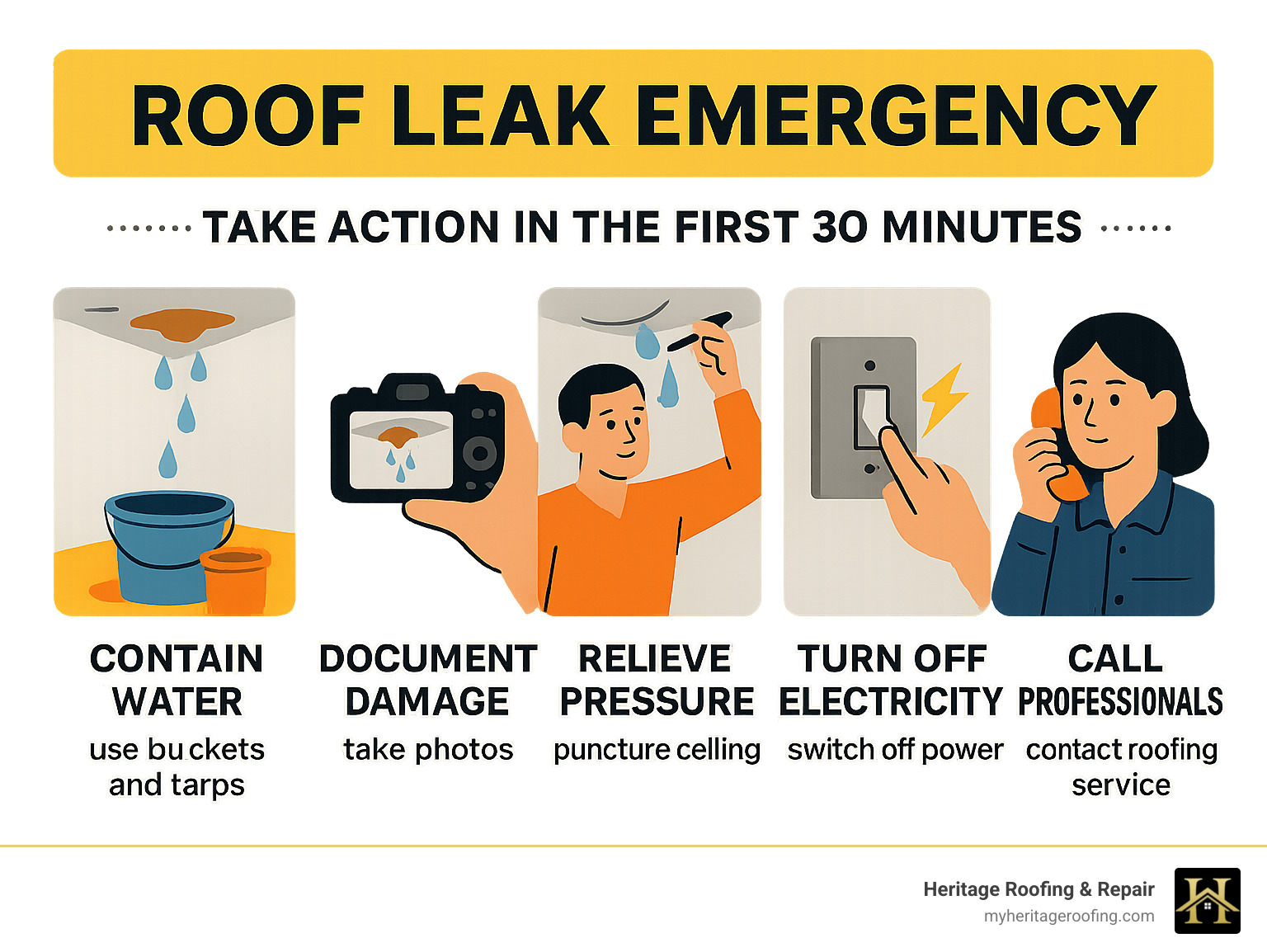
Is It an Emergency? Recognizing the Critical Signs of a Roof Leak
That sinking feeling when you spot water where it shouldn’t be – we’ve all been there. Maybe it’s a mysterious brown stain creeping across your ceiling, or the unmistakable sound of dripping during last night’s storm. The million-dollar question is: do you need to drop everything and call for help, or can this wait until Monday morning?
The truth is, most homeowners underestimate roof leaks until it’s too late. What looks like a small problem on the surface often signals much bigger issues hiding behind your walls and above your ceiling. Getting professional roof repair quickly can save you thousands in the long run.
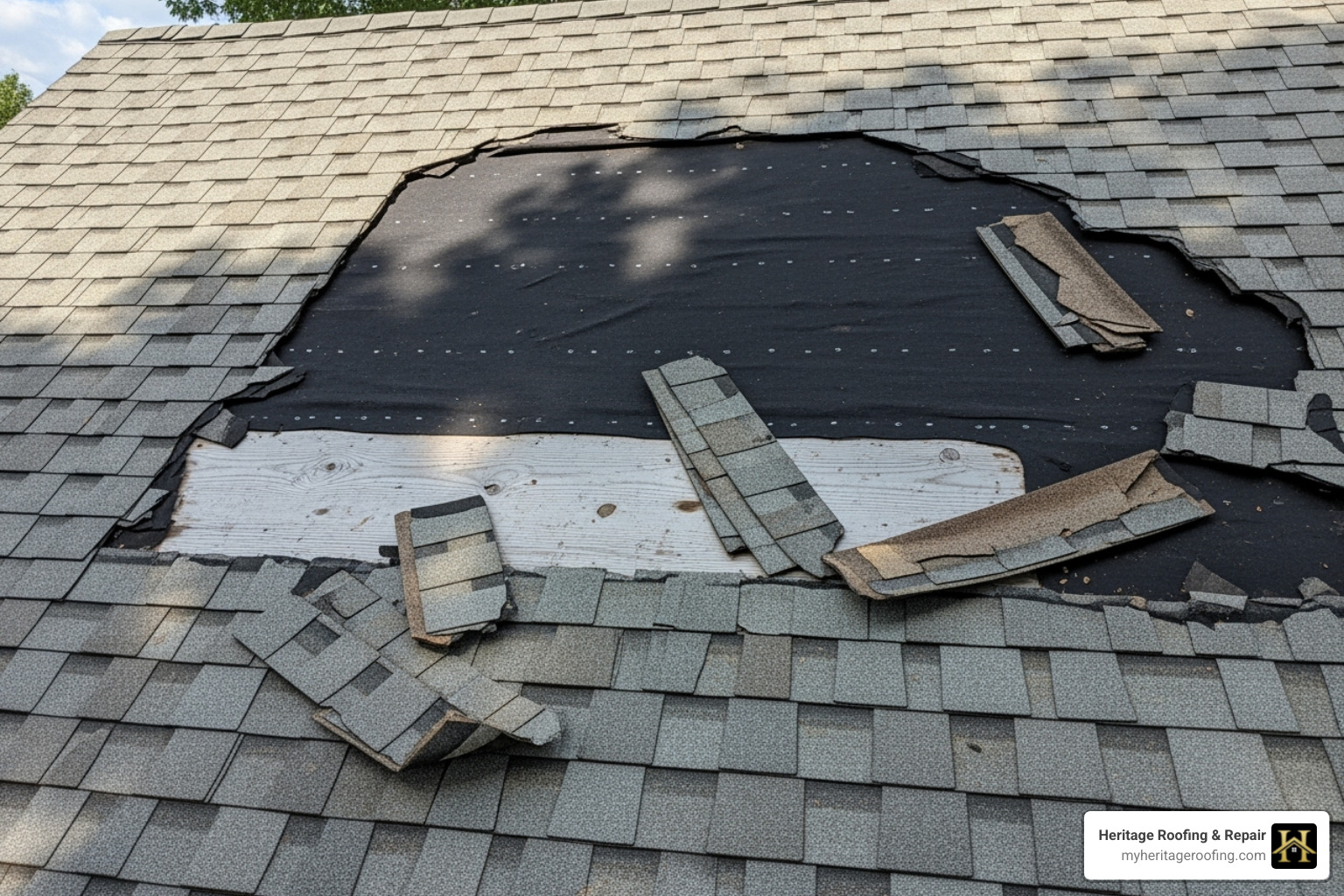
Here’s what to watch for: Water stains on your ceiling are usually your first clue – those yellow, brown, or dark patches that seem to appear overnight. Dripping water is the obvious red flag, but even a slow, steady drip can cause serious damage over time. Puddles forming on your floors mean water has already traveled through multiple layers of your roof structure.
Sometimes the signs are more subtle. Musty odors in your attic or upper floors often point to hidden moisture and potential mold growth from a leak you haven’t spotted yet. Peeling paint or wallpaper can indicate moisture problems even when there’s no visible ceiling damage directly above.
The scary stuff includes sagging drywall or bulging ceiling areas – this means significant water has accumulated and you’re looking at potential structural issues. Visible exterior damage like missing, curled, or damaged shingles leaves your home completely vulnerable to water intrusion. Don’t forget about damaged flashing around chimneys, vents, and skylights – these metal or plastic seals are common leak culprits. For homes that have weathered recent storms, our storm damage roof repair guide covers what storm damage looks like from the outside.
When a Small Drip Becomes a Big Problem
Here’s where many homeowners make a costly mistake – thinking they can “deal with it later.” That innocent-looking bucket catching a slow drip? It’s buying you time, but it’s not solving anything.
Even minor leaks work overtime to damage your home. Water saturates your insulation, making it useless and creating perfect conditions for mold to flourish. It rots the wooden roof decking and framing that holds your entire roof structure together. Meanwhile, mold growth spreads through damp areas, creating health hazards and requiring expensive professional remediation.
Your belongings aren’t safe either – furniture, electronics, family photos, and important documents can all be ruined by persistent moisture. The financial reality is sobering: a simple patch job might cost $150 to $400, but delaying action can lead to structural repairs costing thousands, plus mold remediation fees that can easily reach $3,000 or more.
Clear Indicators of a Roof Leak Emergency
Some situations demand immediate action – no waiting, no hoping it’ll get better on its own. If you see multiple leak spots throughout your home, you’re dealing with widespread roof damage that needs professional attention right now.
Water running down your interior walls is a serious emergency. This level of water intrusion can damage wall materials, ruin paint and flooring, and create dangerous electrical hazards. Visible structural sagging in your ceiling or roof means dangerous water accumulation or compromised structural elements – this is a safety risk that can’t wait.
After severe weather, significant roof damage visible from the ground – large areas of missing shingles, holes, or displaced roofing materials – leaves your home wide open to the elements. This type of damage requires immediate professional intervention to prevent catastrophic water damage.
Manufacturers design roofing systems to handle multiple storms, but even the best materials deteriorate over time. A violent storm can strip away protective layers in minutes, turning a well-maintained roof into a roof leak emergency that needs immediate attention.
Your First 30 Minutes: A Step-by-Step Damage Control Plan
When you find a roof leak emergency, your heart might skip a beat – and that’s completely normal! But here’s the thing: the actions you take in the first 30 minutes can literally save you thousands of dollars in damage. Think of it as your home’s golden hour, where quick thinking and swift action make all the difference.
Safety comes first, always. Before you do anything else, assess the situation for electrical hazards and slip risks. Water and electricity are a dangerous combination, so if the leak is anywhere near outlets, light fixtures, or wiring, head straight to your breaker box and turn off power to that area. When in doubt, shut off the main power entirely.
Step 1: Contain the Drip and Protect Your Home
Your mission right now is simple: stop that water from spreading and causing more damage. Grab the biggest containers you can find – buckets, large bins, even trash cans work perfectly. Position them directly under every drip you can see.
Don’t forget about the sneaky water that’s already on the floor. Lay down towels or old rags around the leak area to soak up standing water and create a barrier against further spreading. It’s like building a fortress against water damage, one towel at a time.
Move everything valuable out of harm’s way. Electronics, furniture, family photos, important documents – get them to safety first. For larger items that can’t be moved easily, throw plastic tarps or sheets over them. Even a shower curtain can work in a pinch!
Step 2: Safely Manage Ceiling Bulges
Here’s where things get a bit nerve-wracking. Sometimes water doesn’t drip immediately – instead, it pools above your ceiling, creating an ominous bulge. This is actually more dangerous than active dripping because that bulge could collapse without warning, dumping gallons of water and ceiling debris all at once.
If you spot a ceiling bulge, don’t panic, but do act quickly. Grab a screwdriver or similar pointed tool and carefully puncture the center of the bulge. Yes, you’re intentionally making a hole in your ceiling, but trust me – it’s much better to control where and when that water comes down.
Position your largest container directly underneath before you puncture. The water will drain out in a controlled stream rather than causing a catastrophic ceiling collapse. This simple step can prevent thousands in additional ceiling repairs.
Step 3: Document Everything for Insurance
While the water is draining into your buckets, it’s time to become a detective. Take photos and videos of everything – the active drips, water stains, damaged belongings, and wet floors. Capture the damage from multiple angles and make sure the images clearly show the extent of the problem.
If it’s safe to do so, step outside and photograph any visible roof damage. Missing shingles, damaged flashing, or obvious holes all need to be documented. Include timestamps on your photos – many smartphones do this automatically.
This documentation becomes your lifeline when filing an insurance claim. Insurance adjusters need clear evidence of the damage, and having thorough documentation can expedite your claim and ensure you receive proper coverage.
Remember: wet floors are slip hazards. As you’re moving around taking photos and managing containers, watch your step. Consider placing towels strategically not just to absorb water, but to create safer walking paths.
The good news? You don’t have to handle this crisis alone. Professional roofing services understand that roof leak emergencies don’t wait for business hours. Many companies, including ours at Heritage Roofing & Repair, provide emergency response with arrival times of four hours or less, 24/7. A real person will answer your emergency call any time, day or night, because we know how stressful these situations can be.
Heritage Roofing & Repair
3458 Arkansas State Hwy 221, Berryville, AR 72616
(870) 654-1164
Temporary Fixes and Finding the Source
Once you’ve contained the immediate flow of water and ensured safety, your next step is to apply a temporary fix if possible and then identify the source of the leak. These are stop-gap measures, not permanent solutions, but they can prevent further damage until professional help arrives.
When facing a roof leak emergency, understanding your options can help you make informed decisions about immediate repairs versus waiting for professional help. Here’s a realistic comparison of what you can expect:
| Feature | DIY Temporary Fixes | Professional Permanent Repairs |
|---|---|---|
| Cost | $20-$100 for materials | $200-$3,000+ depending on damage |
| Time Required | 30 minutes – 2 hours | 2-8 hours for complete repair |
| Effectiveness | Stops immediate water flow | Addresses root cause permanently |
| Safety Risk | High (working on wet roof) | Low (trained professionals) |
| Longevity | Days to weeks | Years with proper materials |
| Pros | Quick, inexpensive, readily available | Long-lasting, warrantied, safe |
| Cons | Temporary only, safety concerns | Higher cost, may require waiting |
How to Apply a Temporary Patch While You Wait
If you’re comfortable working on your roof and conditions are safe, there are a few temporary solutions that can buy you precious time. Roof safety is paramount – never attempt repairs during storms, on wet surfaces, or if you’re uncomfortable with heights.
Roofing cement is your best friend for small cracks or holes. This thick, tar-like substance can be applied directly to the damaged area with a putty knife. It’s available at most hardware stores for around $15-25 and can provide a waterproof seal for several weeks.
For larger damaged areas, roofing sealants offer another option. These come in tubes and can be applied with a caulk gun around flashing, vents, or small gaps. They’re particularly effective for sealing areas where different roofing materials meet.
When dealing with significant damage, roof tarping may be your only temporary option. A heavy-duty tarp secured with roofing nails or weighted down with sandbags can protect large areas from further water intrusion. However, this requires getting on your roof, which can be extremely dangerous in wet conditions.
Important safety note: The Occupational Safety and Health Administration (OSHA) reports that falls from roofs account for over 34% of construction fatalities. If conditions are unsafe or you’re not experienced with roof work, wait for professionals. Your safety is worth more than any temporary fix. For more information, review their guidelines on fall prevention and roof safety procedures.
Locating the Leak’s True Origin
Here’s where things get tricky – water is sneaky and rarely drips straight down from where it enters your roof. The water stain on your ceiling might be several feet away from the actual roof damage. Think of water as following the path of least resistance, traveling along rafters, pipes, or ductwork before finally giving up and dripping into your living space.
Start with your attic if you have safe access. Armed with a flashlight, look for water stains on the rafters, roof decking, or insulation. Fresh water damage will appear darker or discolored compared to dry wood. Follow any wet trails you find – they’ll lead you back to the source.
Pay special attention to vulnerable areas where leaks commonly occur. Chimneys, skylights, vent pipes, and valleys (where two roof planes meet) are frequent culprits. The flashing around these features takes a beating from weather and can crack, separate, or corrode over time.
Water testing can help confirm your suspicions about the leak’s location. On a dry day, have someone spray water from a garden hose on suspected areas while you watch from inside. Start low on the roof and work your way up – this methodical approach helps isolate the exact entry point.
If you’re dealing with a complex leak or multiple entry points, don’t hesitate to call in the experts. Professional roofers have specialized tools like moisture meters and thermal imaging cameras that can pinpoint leaks that might be invisible to the naked eye. For comprehensive leak detection and repair, professional roofing services can save you time and ensure the job is done right the first time.
Temporary fixes are just that – temporary. While they can prevent immediate damage, addressing the root cause requires proper materials, techniques, and often professional expertise. The goal is to keep your home dry until permanent repairs can be completed safely and effectively.
